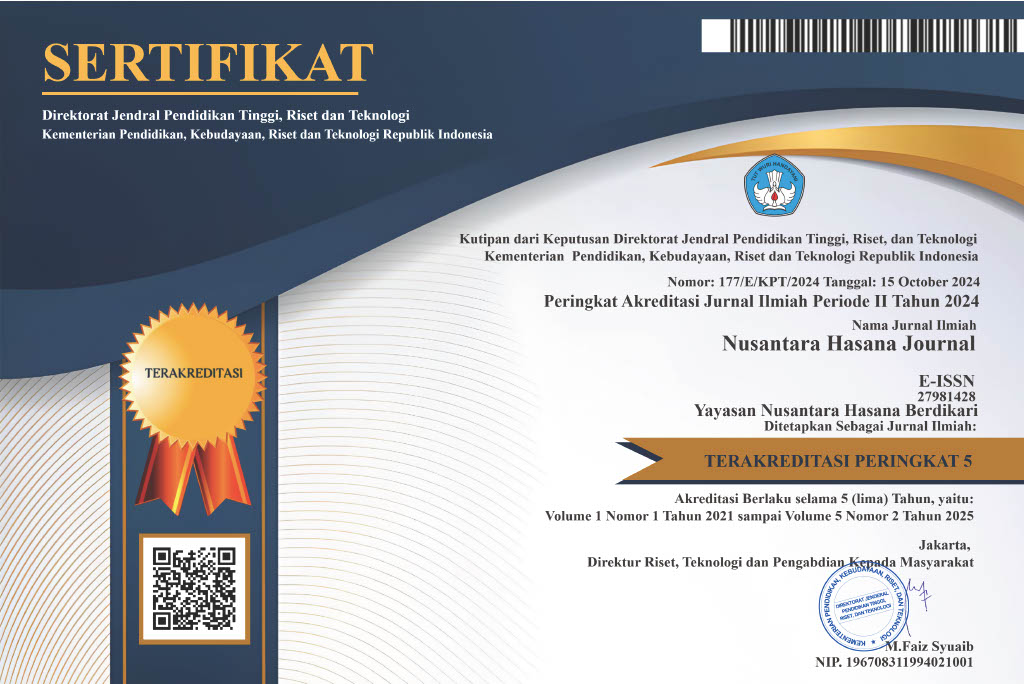PENGARUH PEMASARAN MULTI-SENSORI TERHADAP NIAT BELI ULANG KONSUMEN DUNKIN DONUTS DI BANDAR LAMPUNG
DOI:
https://doi.org/10.59003/nhj.v4i10.1399Keywords:
Multi Sensory Marketing (Sight, Smell, Taste, Sound & Touch), Repurchase IntentionsAbstract
The current phenomenon is that according to the 2024 Top Brand Index Survey, in the last 5 (five) years Dunkin Donuts still ranks second from its competitors. In fact, if you look at it, the company has implemented multi-sensory marketing as a strategy to make customers have repeat purchase intentions. The purpose of this study itself is to find out whether Multi-Sensory Marketing (Sight, Smell, Taste, Sound & Touch) can influence consumer repeat purchase intentions. This study uses a quantitative approach obtained directly from respondents using a Google form questionnaire to 100 respondents with a 5-point Likert scale indicator. This study uses the SPSS analysis tool. The results of partial testing show that multi-sensory marketing variables (sight, smell, taste, sound & touch) have an effect on consumer repeat purchase intentions at Dunkin Donuts.
Downloads
References
Ajzen, Icek. (2002). Perceived Behavioral Control, Self-Efficacy, Locus of Control, and The Theory of Planned Behavior. Organizational Behavior and Human Decission Processes 50, 179-211.
Andrade, J., & Posser, D. (2019). HOW MULTISENSORY EXPERIENCES IN VIRTUAL ENVIRONMENTS AFFECT INTENTION TO RETURN : THE ROLE OF COGNITIVE FLEXIBILITY , SENSE OF POWER AND PERSONALITY TRAITS. October.
Chakravarthy, C. K. (2017). The Upsurge in Frameworks that Emphasise The Importance of MLearning. Journal of English Language And Literature, 4(2), 19–22.
Chan, H., Boksem, M., & Smidts, A. (2018). Neural Profiling of Brands: Mapping Brand Image in Consumers’ Brains with Visual Templates. Journal of Marketing Research, 55(4), 600–615. https://doi.org/10.1509/jmr.17.0019
Chik, T., Zulkepeley, C. and, Tarmizi, A. and, Bachok, F. and, & Sabaianah. (2019). Influence of Social Media on Consumers’ Food Choices. Insight Journal, 4(3), 21–34.
Dung, N. V., Ha, V. N., Anh, T. N., Duong, P. T., Phuong, T. T., & Ha Vy, D. (2022). The Impact of Sensory Marketing on the Intention to Reuse Aviation Services of People in Hanoi City: The Case of Vietnam Airlines. Asian Journal of BasicScience&Research, 04(02), 63–82. https://doi.org/10.38177/ajbsr.2022.4205
Ghozali, Imam. (2018). Aplikasi Analisis Multivariate Dengan Program IBM SPSS 25. Semarang: Badan Penerbit Universitas Diponegoro.
Ghozali, I. (2021). PARTIAL LEAST SQUARES KONSEP, TEKNIK DAN APLIKASI MENGGUNAKAN PROGRAM SMARTPLS 3.2.9 UNTUK EPNELITIAN EMPIRIS (3rd ed.). Badan Penrbit Universitas Diponegoro.
Goh, S. K., Jiang, N., Hak, M. F. A., & Tee, P. L. (2016). Determinants of smartphone repeat purchase intention among Malaysians: A moderation role of social influence and a mediating effect of consumer satisfaction. International Review of Management and Marketing, 6(4), 993–1004.
Goldkuhl, L. and Styfven, M. (2007) Scenting the Scent of Service Success. European Journal of Marketing, 41, 1297-1305. https://doi.org/10.1108/03090560710821189
Hair, et al, 2014, Multivariate Data Analysis, New International Edition., New Jersey : Pearson.
Haritaoglu, G., KOrkmaz, A. T., & Burnaz, S. (2022). A field study on sensory cues and customer revisit intention. Pressacademia, 9, 105–114. https://doi.org/10.17261/pressacademia.2022.1634
Harrop, S. (2007). What role can sensory branding play in online marketing. https://econsultancy.com/what-role-can-sensorybranding-play-in-online-marketing
Hoang, S. D., & Tučková, Z. (2021). The impact of sensory marketing on street food for the return of international visitors: Case study in Vietnam. Scientific Papers of the University of Pardubice, Series D: Faculty of Economics and Administration, 29(2). https://doi.org/10.46585/SP29021282
Hoyer, W. D., MacInnis, D. J., & Pieters, R. (2018). Consumer Behavior (7th ed.). CENGAGE Learning.
Hultén, B. (2011). Sensory marketing: The multi-sensory brand-experience concept. European Business Review, 23(3), 256–273. https://doi.org/10.1108/09555341111130245
Hultén, B., Broweus, N., & van Dijk, M. (2009). Sensory marketing. In Sensory Marketing. https://doi.org/10.1057/9780230237049
Isaac, N., Keelson, S. A., & Yiadom, E. B. (2023). The Effect of Multi-Sensory Marketing on Non-Economic Performance of Ghana’s Restaurants. OALib, 10(06), 1–31. https://doi.org/10.4236/oalib.1109655
Jain, R., & Bagdare, S. (2011). Music and consumption experience: a review. International Journal of Retail & Distribution Management, 39(4), 289–302. https://doi.org/10.1108/09590551111117554
Jang, H. (2019). sustainability Applying E ff ective Sensory Marketing to Sustainable Co ff ee Shop Business Management.
Kim, W. H., Lee, S. H., & Kim, K. S. (2020). Effects of sensory marketing on customer satisfaction and revisit intention in the hotel industry: the moderating roles of customers’ prior experience and gender. Anatolia, 31(4), 523–535. https://doi.org/10.1080/13032917.2020.1783692
Kotler, P., & Keller, K. L. (2016). Marketing Management (S. Wall (ed.); 15th ed.). Pearson Education Limited.
Krishna, A. (2012). An integrative review of sensory marketing: Engaging the senses to affect perception, judgment and behavior. Journal of Consumer Psychology, 22(3), 332–351. https://doi.org/10.1016/j.jcps.2011.08.003
Li, dkk. 2020. Early transmission dynamics in Wuhan, China, of novel coronavirusinfected pneumonia. N. New England Journal of Medicine. 382(13):1199-1207
Lin, M.T.Y. (2019) Effects of Experiential Marketing on Experience Value and Customer Satisfaction in Ecotourism. Ekoloji, 28, 3151-3156.
Lindstrom, M. (2005). Broad sensory branding. Journal of Product & Brand Management, 14(2), 84-87. https://doi.org/10.1108/10610420510592554
Liu, S. Q., Bogicevic, V., & Mattila, A. S. (2018). Circular vs. angular servicescape: “Shaping” customer response to a fast service encounter pace. Journal of Business Research, 89(April 2017), 47–56. https://doi.org/10.1016/j.jbusres.2018.04.007
Liu, Y., & Jang, S. S. (2009). International Journal of Hospitality Management Perceptions of Chinese restaurants in the U . S .: What affects customer satisfaction and behavioral intentions ? International Journal of Hospitality Management, 28, 338–348. https://doi.org/10.1016/j.ijhm.2008.10.008
Megantara, I. M. T., & Suryani, A. (2016). Penentu Niat Pembelian Kembali Tiket Pesawat Secara Online Pada Situs Traveloka.Com. E-Jurnal Manajemen Unud, Vol. 5,(No. 8, 2016:), 1–28.
Moreira, A.C., Fortes, N. and Santiago, R. (2017) Influence of Sensory Stimuli on Brand Experience, Brand Equity and Purchase Intention. Journal of Business Economics and Management, 18, 68-83. https://doi.org/10.3846/16111699.2016.1252793
Muhamad, F., Suharyono, S., & Alfisyahr, R. (2017). Pengaruh Sensory Marketing terhadap Kepuasan Konsumen dan Repurchase Intention (Survei pada Konsumen Nomu 9 Bites & Beverages di Kota Malang) (Doctoral dissertation, Brawijaya University).
Murimi, M. W., Chrisman, M., McCollum, H. R., & Mcdonald, O. (2016). A Qualitative Study on Factors that Influence Students’ Food Choices. Journal of Nutrition & Health, 2(1), 1–6. https://doi.org/10.13188/2469-4185.1000013
Nandhini, C., Ganesh, P., Yoganathan, K. & Kumar, D. 2019. Efficacy of Colletotrichumgleosporioides, potential fungi for bio control of Echinochloa crus-gali (Barmyard grass). Journal of Drug Delivery and Therapeutics 9(6):72-75.
Oh, H. and Kim, K. (2017) Customer Satisfaction, Service Quality, and Customer Value: Years 2000-2015. International Journal of Contemporary Hospitality Management, 29, 2-29. https://doi.org/10.1108/IJCHM-10-2015-0594
Peck, J. and Childers, T.L. (2008) Sensory Factors and Consumer Behavior. In: Kardes, F., Haugtvedt, C. and Herr, P., Eds., Handbook of Consumer Psychology, Erlbaum, Mahwah, 193-219.
Priyatno, D. (2014). SPSS 22: Pengolah Data Terpraktis. Andi
Priyanto, Duwi.2010.Paham Analisa Statistik Data Dengan SPSS. Mediakom, Yogyakarta.
Puspitawati, E. T. (2023). Studi experimental marketing dalam mengeksplorasi hubungan kausal antara multi sensory marketing, brand experience dan customers perceived value (Studi kasus pada konsumen Lazada) [Skripsi, Universitas Islam Sultan Agung Semarang].
Putri, Budi Rahayu Tanama. 2014. Manajemen Pemasaran. Bali: Fakultas Peternakan Universitas Udayana.
Savitri, I. A. P. D., & Wardana, I. M. (2018). Fakultas Ekonomi dan Bisnis Universitas Udayana ( Unud ), Bali , Indonesia Kosmetik adalah bahan atau sediaan yang dimaksudkan untuk digunakan pada bagian luar tubuh manusia seperti : epidermis , rambut , kuku , bibir dan organ genital bagian luar atau gi. E-Jurnal Manajemen Unud, 7(10), 5748–5782.
Schiffman, L. G., & Wisenblit, J. (2019). Consumer Consumer Behavior (12th ed.). Pearson Education Limited.
Sekaran, U., & Bougie, R. (2017). Metode Penelitian untuk bisnis ( kwan men Yon (ed.); edisi 6-bu). penerbit salemba empat.
Srichaichanwong, T. (2021). The Influence of Sensory Marketing on Customer Satisfaction and Repurchase Intention for Plant-Based Proteins [Tesis, Universitas Thammasat].
Sugiyono. (2021). Metode Penelitian Kuantitatif, Kualitatitf, dan R&D (28th ed.). alfabeta
Sugiyono. (2017). Metode Penelitian Bisnis Pendekatan Kuantitatif, Kualitatif, Kombinasi, dan R&D. Alfabeta, CV.
Tangchaiburana S., Techametheekul KW (2017). Model pengembangan elemen desain web untuk e-commerce pakaian berdasarkan konsep kustomisasi massal. Kasetsart J. Soc. Sci. 38 242–250. 10.1016/j.kjss.2016.07.007
Xie, L., Poon, P. and Zhang, W. (2017) Brand Experience and Customer Citizenship Behavior: The Role of Brand Relationship Quality. Journal of Consumer Marketing, 34, 268-280. https://doi.org/10.1108/JCM-02-2016-1726
Yilmaz, A., Dyer, A. G., Rössler, W., & Spaethe, J. (2017). Innate colour preference, individual learning and memory retention in the ant Camponotus blandus. Journal of Experimental Biology, 220(18), 3315–3326. https://doi.org/10.1242/jeb.158501
Downloads
Published
How to Cite
Issue
Section
License
Copyright (c) 2025 Kurnia Prastyanti

This work is licensed under a Creative Commons Attribution-NonCommercial-ShareAlike 4.0 International License.
NHJ is licensed under a Creative Commons Attribution-NonCommercial-ShareAlike 4.0 International License.
Articles in this journal are Open Access articles published under the Creative Commons CC BY-NC-SA License This license permits use, distribution and reproduction in any medium for non-commercial purposes only, provided the original work and source is properly cited.
Any derivative of the original must be distributed under the same license as the original.
























